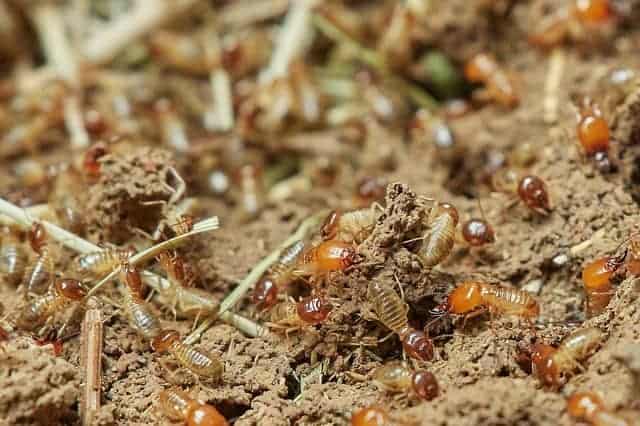In this article, I’ve outlined some termite prevention tips to help protect your structures from termites.
Active fight against termites, including termite fumigation and using the best termite killers.
In summary, termite prevention starts by reducing the wood-to-soil contract around the structures, remove the cardboard, paper, mulch, plants, wood, or lumber near the structure’s foundation. Also, build a 4-inch termite barrier between your house and the mulch.
[amazon bestseller=”Best Termite Killers” items=”2″ template=”table”]4 Indoor Termite Prevention Tips
1. Seal Windows and Doors Tightly
Also, close up openings that termites may use in your house (using caulk, grout, and cement), fix leaks in the indoor spaces, open blocked vents, clear shrubs and trees around the structures.
So, seal off the windows and doors to prevent the termites’ entry form where they’d eat up the structure’s wooden skeleton. Besides, on rooftops and siding, seal up the crevices and cracks.
Notably, termites are small in size and may even get into the house through spaces under the doors or even via broken glass. Inspect for any possible entry points for the termites.
2. Clear Wood, Cellulose, Debris, and Timber
Avoid pilling up wood debris or store firewood around the house and conduct appropriate termite inspection (see also the termite inspection costs).
So, clear wood, cellulose, debris, and timber that’s lying around, under, or in your house or structures. The materials have cellulose that’s good food for subterranean termites (treatment) – and will thus attract the bugs to the indoor spaces.
Wood and other related materials around the house will hide signs of termite attack. Thus, clear all the dead leaves or debris and wood and wooden pieces that may be lying around your structures and property.
3. Mop Up Plus Repair Leaking Pipes and Traps
To prevent and control termites in the indoor spaces, you’ll need to keep the soil that’s near your structure’s foundation dry (with good drainage and grading).
So, net, you’ll need to repair all the leaking pipes and taps in the indoor spaces. Also, check on the overflow pipes for hot water inside, around, or under the house. This will prevent an attack from the subterranean termites.
Also, mop up any moisture around and inside the house as this could easily rear a colony of termites. Termites love basins of water in the house, and hence you must keep your house dry and adequately aerated.
Related: Best Termite Bait Stations
4. Inspect Wooden Floors and Furniture
Next, you’ll need to inspect the wooden floors and furniture. This will also involve inspecting the wooden structures, wooden beams, and joists since termites hide and feed on the cellulose.
Further, you must inspect and clean up the hardwood floors in your house to ensure the termites won’t be hiding or chewing your wooden structures.
Also, block all the open floor vents and openings since poor ventilation may cause a rise in moisture and humidity in your property – this increases the risk of termite infestation.
Clothes may also attract termites into your house, and thus you’ll need to remove the clothing piles. Clothes also have cellulose and hence will attract and feed termites.
3 Indoor Termite Prevention Tips
1. Use Galvanized post or Create 2-Inch Clearance for Wooden Fences
Next, you’ll create some 2-Inch Clearance as you set up your wooden fences plus their supporting posts from the soil. Definitely, the wooden timbers lying on the soil would rear a termite colony.
Therefore, I would recommend using the galvanized post to elevate the wood from the soil and deny the termites an easy reach to feed on the insects.
Next, repair and bits of the roof that’s broken. Further, clear all the woodpiles that may be stacked around your property, including tree trunks, damp or rotten logs.
Ensure you only install the termite-treated fence posts and walls, particularly for the perimeter and garden beds, to prevent termite attacks in the yard.
2. Clear Dead Tree Stumps
However, ensure that the yard or garden remains clean and neat – including clearing the overgrowth by trimming the grass and flower bed weeds.
Next, you’ll clean the stumps and dead trees. Termites love the wood cellulose from the stumps and dead trees. Therefore, remove these dead food sources to prevent attacks from termites.
Prevent bushy gardens and climbing plants from growing around your structures and house. Such plants may provide food for the termites plus a ladder for the insects to climb onto wooden parts of your structures.
3. Inspect and Repair Termite Shielding
Keenly inspect and repair any broken or compromised termite shielding. These would allow you to detect the presence of termites during random inspections easily.
Also, ensure that you uproot any roots that may be tending to break into the house foundation. Avoid planting trees with strong roots that could break the slab and allow termites to gain entry into your house.
Take note of any home addition or alterations as some of these could tamper with already installed termite barriers. Installing some new plumbing, concrete slab, awnings, or gazebo? Well, do a termite barrier audit after this process.
Remove all the timber form-work as this may provide an easy avenue for the termite to attack your house. Finally, don’ dump air conditioning liquids or hot water near the house foundation.
Conclusion
For the outdoor spaces, termite prevention is an equal tasking job for homeowners. Thus, below I’ve outlined the steps you can take to protect the exterior of your house, including the perimeter.
